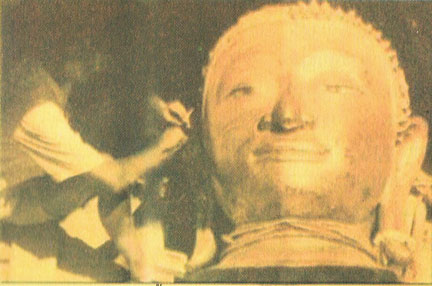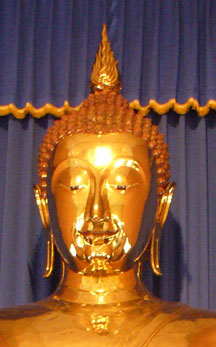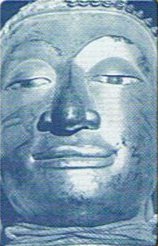
Pra Buddha Mahasuwan Patimakorn (Golden Buddha)
May the miraculous power of Pra Buddha Mahasuwan Pathimakorn or Pra Sukhothai Trimitr Golden Buddha Image protect all of you from all perils and make
you feel welcom to this sacred ground.
The history of this Golden Buddha Image is fiest to be presented to you so as to create in you understanding and spiritual apprehension of this holy wonder. Pra Huddha Mahasuwan Pathimakorn is a Sukhothai style, eighteenkarat gold, seated Buddha image in the attitude of Subduing Mara, cast more than seven handred years ago in the reign of King Ramkhamhaeng the Great the third monarch of Pra Ruang Dynasty. Its size is six cubits and five inches in width at the lap
span, and seven cubits one span and nine inches in heightfrom base to top, weighing approximately five and a half tons. This Buddha image is an embodiment of physical characteristics of the Great Man, presented in an exquisite art form with all lines and curves contributing to the seemingly animate quality, rendering an impression that this sculpture was created by divine power. It is one of the major Buddha images in Thailand and also the first golden Buddha statue of the
country to be recorded in the Guiness book of World Records as an invaluable object of worship, made of pur gold, dated to the fifteenth century, weighing
five and half tons, 3.04 meters in height, seated at Wat Trimitrwittayaram, Bangkok, Thailand, This statue is considered an object of wonder for three reasons:
Its immense size of six cubits and fove inches in wibth at the lap span, and seven cubith, one span and nine inches in height.
Its being an exquisite representative of the physical characteristics of Lord Buddha, created some seven hundred years ago during the Kingdom of
Sukhothai.
Its being cast in pure gold, with dthe price value recorded by the Guiness Book of World Records as 28.5 million pounds.
Originally, this Buddha image was covered with plaster and housed in the ordination hall of Wat Chotanaram or Wat Phrayakrai a royal temple in
Khet Yannawa, Bangkok, which is at present the site of the East Asiatic Co.Ltd.
It is evident that Wat Chotanaram, formerly known as Wat Phrayakrai, was constructed before 1801. later, Phraya Chodeukrajasetthi (Dhao Sua Boonma)
King Rama III's trade commissioner, had this temple renovated in honor of dsthe King. The temple thus came under the royal sponsorship and was made a
royal monastery under new title of Wat Chotanaram. During the reigns of King Rama IV and V, this temple was left uncared-for, causing all the buildings on the temple grongd including the ordination hall to fall into a ruinous state. During this time, the East Asiatic Co>Ltd> applied for permission from the authority to rent the monastery estate for business purposes. Once the permission was granted, the company directed the demolition of all ruinous buidings, except for the ordination hall where a plastered Buddha image and a bronze one, of the same size, were located. The Buddhist Ecclesiastical Committee ordered Wat
Trimitrwittararam and Wat Phaingen Chotanaram to take care of the two Buddha images. In 1935. Wat Phaihgen Chotanaram had the bronze Buddha image
transferred to its temple ground, and Wat Traimitrwittayaram led by Pra Maha Chiam Kamalo had the plastered Buddha image installed first in a corrugated-iron shack by the side of a delapidated chedi on the east side of the old ordination hall of Wat Traimitrwittayaram.

Wat Traimitrwitayaram
The plastered Buddha image had been kept there for twenty years before the plaster coating chipped off, revealing the gold surface underneath on
May 25, 1955 the tiime very close to the commemoration of the twenty-fifth Buddhist Era. This occurrence has been regarded by Buddhists in Thailand as a miracle.
In the old days, Wat Traimitrwittayaram originally known as Wat Samcheen was located in a low-lying area, surrounded by canals. The temple ground
was flooded almost all year round. The temple committee, chaired by the abbot Pra Weeradhammunee, together with other committee members, soch as
Captain Luang Supphachalasai, Luang Boribalwejakit, Mr. Sanit Tewinpakdhee and Mr. Kamthorn Wisuthiphol, had all the temple's buildings renovated and a new ordination hall was completed in 1939, when the temple's title was changed from Wat Samcheen to Wat Traimitrwittayaram. In 1954, a new Viharn building was built to house the plastered Buddha image tranferred from Wat Chotanaram.
Upon the completion of the construction of the Viharn building a 20 m. x 28 m. Thaistyle building with four gable ends, Wat Traimitrwittaryram had the plastered Buddha image transferred from the shack to the new Viharn building on May 25, 1955. This was not easy work at all. Due to the lack of any
sophisticated labor-saving devices, the moving of the statue had to rely on man-power and a pulley, working from early morning till late afternoon. During
the final attempt to lift the Buddha image so as to place it inside the Viharn, the ropes that fastened around the large image were broken, causing it to fall from the pulley and hit hard on the concrete ground. In this way, the plaster coating came off, allowing the gold surface underneath to be seen. After that the plaster coating all over the statue was removed. It was found that the whole statue was made of pure gold and in a perfect condition. At the present time, this Buddha
image remains in the same state as when its coating was taken off. Pictures of different stages of plaster coating removal were taken and are now displayed in
the Viharn as evidence to show the younger generation how subtle their ancextors were in their attempt to reserve an invaluable object of worship. Those who are interested in seeing or playing respect to this gold Buddha image are welcome to Wat Traimitrwittararam from 8.00am.- 5.00 pm. daily,

Pra Buddha Mahasuwan Pathimakorn
or
Pra sukhothai Traimitr Golden Buddha image
is
The golden Buddha image mentioned in the stone tablet of King Ramkhamhaegn Great.
Is was recorded on the second side, lines 23-26, of the second Paa tarl stone tablet, of King Mamkhamhaeng the Great, that reads : "there is a
Viharn in Wat Mahathat in the middle of Muang Sukhothai, where a golden Buddha image, Phra Attharote (or eight-cubit standing Buddha image), and other Buddha image,such as large and middle-size Buddha statues, are kept. "Careful investigation of characteristics of Phra Buddha Mahasuwan Pathimakorn, its being cast in the Sukhothai style, its gigantic size and the weight of pure gold used in its scupturing have all given rise to an assumption that Phra Buddha Mahasuwan Pathimakorn is the same as the golden Buddha image recorded in the Paa Tarl stone tablet of King Ramkhamhaeng the Great because it was a
large gold Buddha image, and so significant to reign of this great monarch that it was referred to as part of Sukhothai history on the stone tablet.
Otheer evidence is that all Buddha images mentioned in the Paa Tarl stone tablet were large. Phra Buddha Mahasuwan Pathimakorn of Wat
Traimitrwittararam is regarded as compatible in size to the golden Buddha image of the King Ramkhamhaeng period, and no other golden Duddha image of this size could be found elsewhere. Therefore, it is assumed that Phra Buddha Mahasuwan Pathimakorn is the same as the Golden Buddha image of the
Paa Tarl tablet.

Golden Buddha image
Characleristics of Pure Sukhothai style buddha images.
Sukhothai style Buddha images are divided into many periods and divisions. The central period or the major division is considered the highlight of pure
Sukhothai style Buddha images, cast during the reign of King Ramkhamhaeng the Great. Major characteristics of Sukhothai style Buddha statues are as follows;
1 Flame like halo,
2 Small hair curls, with no band of hair edge.
3 Curved eyebrows, slender and pointed nose,tapering chin,
4 Embossed crow and nipples.
5 Forked and tapering robe-end, folded in creases. Sitting crosslegged with both shins paralled to the ground.
The base of this statue is a plain concave platform, unlike that of the Chiengsaen style Buddha image, which is in the form of a plain convex base. It is noticeable that the central period or the major division of the Sukhothai style Buddha statues would not make use of lotus-petal bases. This form of base would be popular in the later period or the Phra Buddha Chinaraj division.
Characteristics of Phra Buddha Mahasuwan Pathimakorn or Phra Sukhothai Traimitr Golden Buddha image.
From careful examination of Phra Buddha Mahasuwan Pathimakorn, it is found that major physical characteristics of Lord Buddha can be seen in this statue from the top to the base as follows:-
1 Exquisite flame-like halo,
2 Embossed crown,
3 Soft hair between eyebrows,
4 Small hair cuels, with no band of hair edge.
5 Curved eyebrows,
6 Slender and pointed nose,
7 Thin lips with smiling expression.
8 Oval face.
9 Not so plump cheeks like those of Phra Buddha Chinaraj but in good proportion with the oval face.
10 Tapering chin,
11 Lotus petal like earlobes.
12 Pierced earlobes, like those of Sukhothai citizens of King Ramkhamhaeng's period.
13 Circular bands around the neck.
14 Broad and muscular chest like that of a lion,
15Broad shoulders, in appropriate proportion with the body,
16Long arms, placed in the same style as elephant trunks,
17 Four fingers tips not of the same length, like those of human beings (those of Buddha images of later period are of equal length),
18 Embossed nipples,
19 Forked and tapering robe ends, folded in creases, with the front robe end extending to the navel and the back one stretching to the base
20 Sitting cross legged with both skins parallel to the ground and the soles lying flatsuggesting liberation from all lustful desires and the curved rim of the outer robe.
21 Plain concave base,
22 Thin transparent robe,
23 Sitting in the position that creates an impression that Lord Buddha is present and thus stirs a sense of repect in worshipper,
24 Left arm placed on the lap, and right arm pointing to the ground.
Despite being a seated statue, this image looks animate and its facial expression gives a feeling that it could talk to worshippers.
The physical characteristics of Phra Buddha Mahasuwan Pathimakorn match with those of Buddha images created during the peak of Sukhothai
art or King Ramkhamhaeng's period. This leads to the final conclusion that the Wat Traimitrwittayaram golden Buddha image is the same as the one cast during the aforementioned time.
Reasone for being Transferred to Wat Chotanaram
Changes are the undentable rule that governs worldly power and these changes also affect the location of the golden Buddha image mentioned in the
Paa Tarn tablet.
With the gradual decline of the powerful and illustrious Sukhothai Kingdom and its sumission to Ayutthaya during the end of the reign of Phraya paan
(King Maha Dhamaraja IV), the Golden Buddha image, which once adorned the Viharn building of Wat Phra Mahathat in the middle of the Sukhothai
Kingdom, was transferred to the south and placed in the Ayutthaya Kingdom in 1403.
Throughout its history that lasted 261 years,the Ayutthaya Kingdom had experienced ups and downs. At one time, it reached its peak of administation and
development, at another it fell to the Burmese. In 1767, it came under the vassalage of Burma. The capital, together with temples, was ransacked and burnt
to the ground.
Even the Kingdom's principal Buddha image by the name of Phra Srisanpetch, a thirty-two cubit statue covered with gold with a weight of 171.6 kilograms,
was burnt and all the gold was peeled off, leaving only the brick structure inside.
While Ayutthaya and its temples were desroyed by the enemy, it was afraid that the golden Buddha image transferred from Sukhothai would face the same destiny as Phra Srisanpetch. The image was thus coated with plaster, leading the enemy to believe that this was one of the brick-plastered Buddha images that could be seen all over this capital, this was such a subtle way to save the object of worship or the inheritance of immense value from the reign of King Ramkhamhaeng the Great from the hand of the destroyer. The golden Buddha image was thus placed among other plastered images in ayutthaya.
In 1801, after King Buddha Yodf ah the Great (Rama I) established Bangkok as a new capital city of the Kingdom, he ordered his highranking officials to transfer ruinous Buddha images from various deseerted temples in Sukhothai, Sawankhalok, Pitsanulok, Lop Buri, and the ancient capital of Ayutthaya to be
installed in the inner and outer galleries around the ordination hall of Wat Phra Chetuponwimonmungkalaram or Wat Pho, Taa Tien, Khet Phra Nakhon,
Bangkok Metropolis. The plaster covered golden Buddha image was among those that were moved to Bangkok. It was later housed as a principal Buddha image in the ordination hall of Wat Chotanaram or Wat Phrayakri, Khet Yannawa, Bangkok Metropolis. In 1935, it was transterred to be seated at Wat Traimitrwittayaram, Khet Sumpaunthawong, because the plaster coating chipped off, it was found in 1955 that this was a pure golden Buddha image. In 1992,
his Majesty the King bestowed an official name upon this golden Buddha image as Pha Buddha Mahasuwanpathimakorn.
All above mentioned is the history of Phra Buddha Mahasuwanpathimakorn or Phra Sukhothai Traimitr Golden Buddha image, which is believed to be the Golden Buddha image recorded in the Paa Tarn stone tabled of Muang Sukhothai, one of the most important heritages of King Ramkhamhaeng the Great the Scholarly Monarch of the Thais. At present, this statue is considered one of the worlds wonders.
The End

